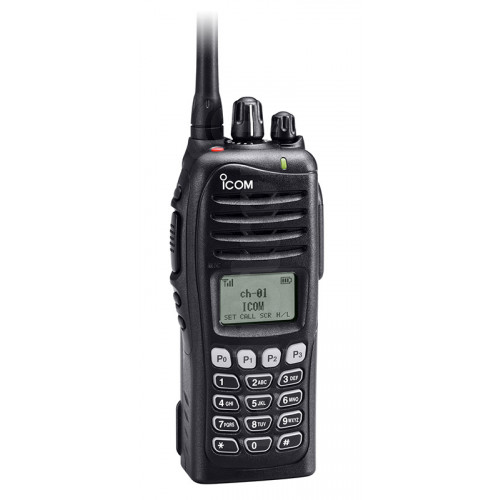VHF TRANSCEIVER (Icom IC-F3062T) 136-174MHz
NST
PCOMVHFEI30T
Valid Article
Account code:
61160
HS Code:
852560
Last Updated on:
05/12/2025, 22:30:10
Former
Code(s):
PCOMTRVI32-
Hazardous materials and products (identified by their 4-digit transport UN-number) must be transported under certain conditions as specified in the MSDS sheet (Material Safety Data Sheet).
TRANSCEIVER, VHF (Icom ICF3062T)
Definition
Portable VHF radio, wide band, programmable, intended for short distance voice communications.
Specifications
- Power output: 5 W on 136-174 MHz
- Flexible rubber antenna, 146-174 MHz, ¼ wave, screw mounted male connector
- CTCSS encoder, decoder and DTMF
- Rechargeable battery BP-232N Li-Ion, 2000 mAh
- Channel selector knob with 16 positions
- Programmable channels: 512 (16 banks)
- Rapid charger: ICOM Icom BC 119N + IC-AD106, 2 h charge cycle, with AC adapter
- IP 54/55: dust protection, splash and water jet resistance
Some restricted information has been hidden. Sign in
to see this information
Transport Dangerous Goods
WARNING:
For air transportation this item is regulated, as it is classified as hazardous good by IATA:
- UN3481 Lithium ion batteries contained in equipment
- Class: 9
- Packing Instructions: 967 Section II
- The label must include the UN code of the battery + an emergency number to contact in case of an incident
- Limit per package:
- Pax A/C (Passengers & Cargo Aircraft) = 5 kg
- CAO (Cargo Aircraft Only) = 5 kg
For maritime transport: not restricted as per special provision IMDG 188.
Instructions for use
Always inquire about local authorizations to be obtained.
Never transport a handset by its antenna as it is very fragile.
NEVER transmit without antenna.
The handset range depends on environmental conditions, and is 8 km maximum.
Radios are pre-programmed on standard frequencies, for immediate use.
Some restricted information has been hidden. Sign in
to see this information


![[PCOMVHFAI0TCC] (VHF Icom F3162T/3062T/4062T) CLONING CABLE (OPC-1536)](/web/image/product.template/548824/image_256/%5BPCOMVHFAI0TCC%5D%20%28VHF%20Icom%20F3162T-3062T-4062T%29%20CLONING%20CABLE%20%28OPC-1536%29?unique=b548868)
![[PCOMVHFAI0TDC] (VHF Icom F3262DT/3162T/3062T/4062T) CABLE for charger, 12V](/web/image/product.template/548828/image_256/%5BPCOMVHFAI0TDC%5D%20%28VHF%20Icom%20F3262DT-3162T-3062T-4062T%29%20CABLE%20for%20charger%2C%2012V?unique=131c244)
![[PCOMVHFAI0TP] (VHF Icom F3162T/3062T/4062T) BELT CLIP](/web/image/product.template/548823/image_256/%5BPCOMVHFAI0TP%5D%20%28VHF%20Icom%20F3162T-3062T-4062T%29%20BELT%20CLIP?unique=131c244)
![[PCOMVHFAI0TS] (VHF Icom F3262DT/3162T/3062T/4062T) SOFT CASE](/web/image/product.template/548834/image_256/%5BPCOMVHFAI0TS%5D%20%28VHF%20Icom%20F3262DT-3162T-3062T-4062T%29%20SOFT%20CASE?unique=b548868)